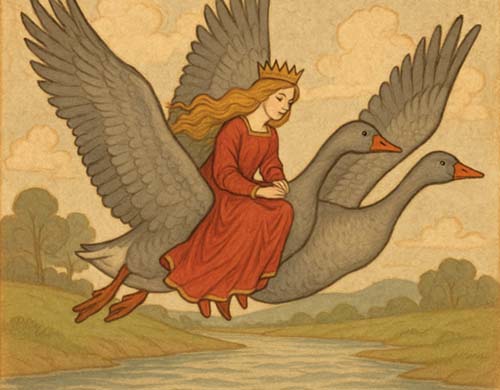Grey Goose and Gander
Grey goose and gander,
Waft your wings together,
And carry the good king's daughter
Over the one-strand river.

Origin
The nursery rhyme Grey Goose and Gander was recorded in Andrew Lang’s Nursery Rhyme Book (1897), with illustrations by L. Leslie Brooke.
The rhyme also appears in English folk-song collections. Traditional singers in Yorkshire and Lancashire were known to perform it, sometimes in much longer versions. These tended to be sung rather than recited, which suggests the piece straddled the line between a children’s rhyme and a folk song.
Meaning
Like many short nursery rhymes, the meaning is hazy. The image of geese carrying a king’s daughter across a “one-strand river” has no clear allegory in history or politics. Some scholars class it as nonsense verse — playful words chosen for rhythm and melody rather than for moral or political commentary.
Still, it may carry faint echoes of old folklore. Birds often act as helpers or messengers in fairy tales, and rivers often mark the boundary between two worlds. The rhyme could preserve a fragment of that imagery, pared down into a children’s chant.
Variants
Folk-song collectors note that Grey Goose and Gander was sung with different words in various districts. In some cases, extra lines were added with refrains such as “by the light of the moon,” or the verses wandered into unrelated nonsense. Joseph Kidson, writing on northern folk songs, admitted it was “a very silly one,” yet it was widely sung in kitchens and taverns.
The short four-line nursery version seems to be a polished print form, while the longer sung versions lived on in oral tradition.
Geese show up often in British children’s lore — from Goosey, Goosey Gander to Mother Goose. They were everyday farm animals, familiar to children, but also had a touch of folklore magic: protective, noisy, and tied to old seasonal festivals. In this rhyme, the goose is magnified into a mythical creature able to carry royalty over a river.
The phrase “one-strand river” is unusual. It may simply mean a narrow stream, but some readers see it as a poetic image — a single shining thread of water, thin yet uncrossable without help. That line, perhaps more than anything, gives the rhyme its strange and haunting quality.
